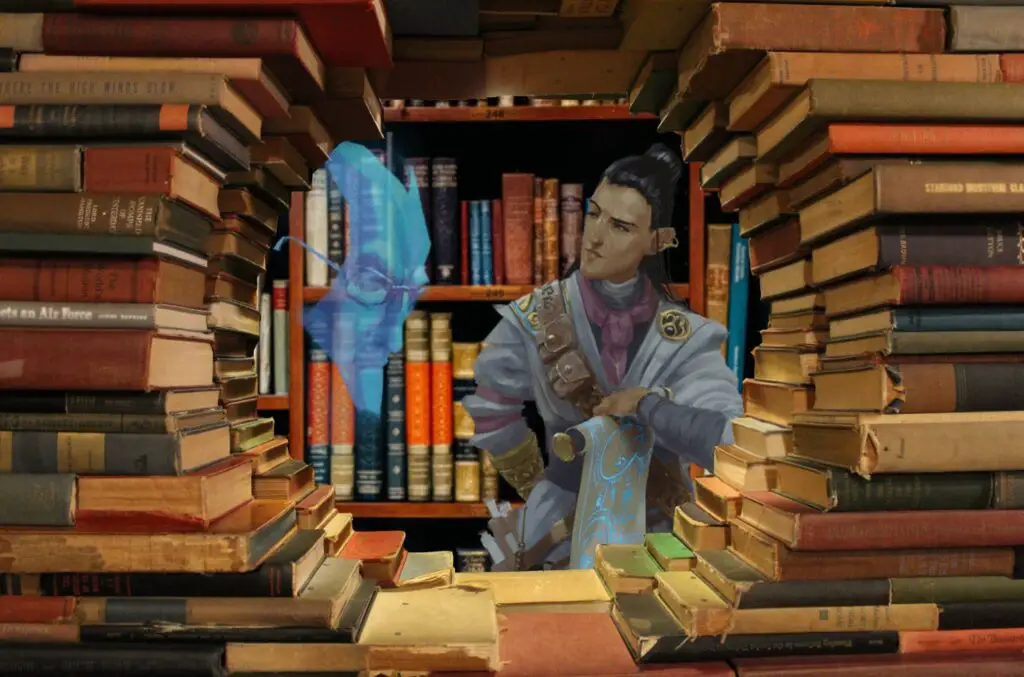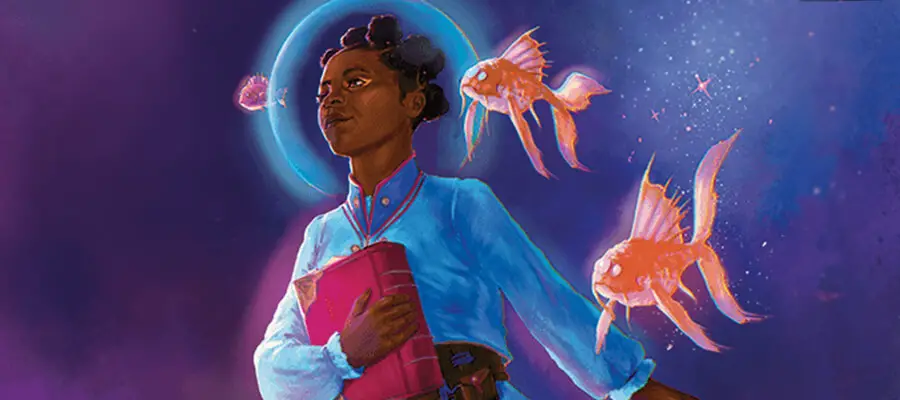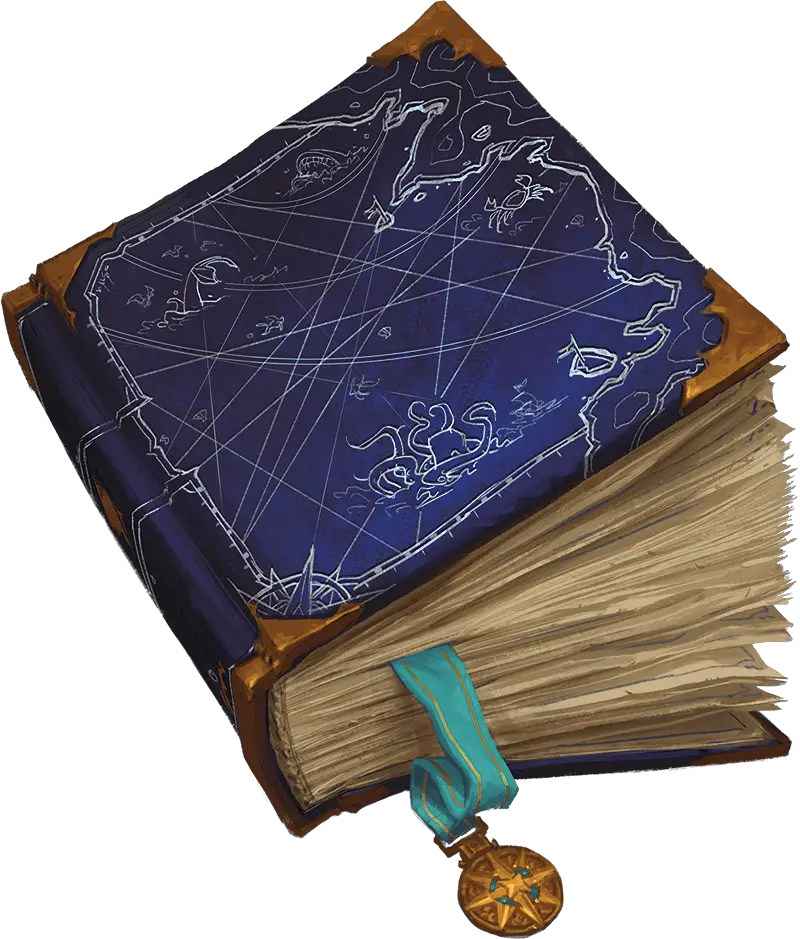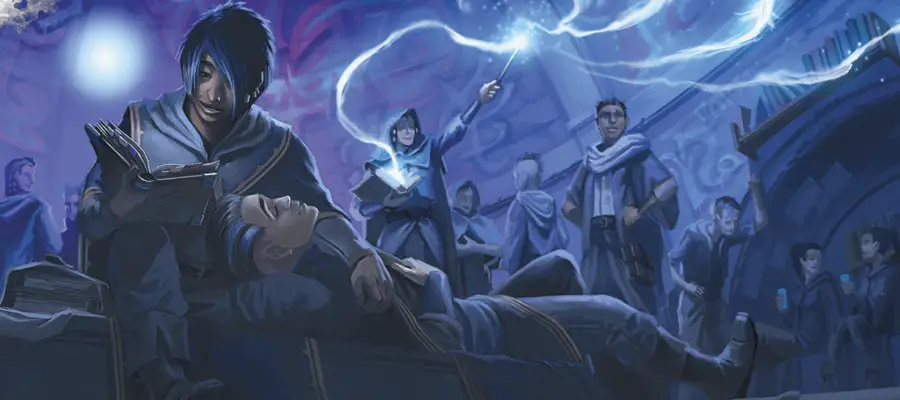Featured Order of Scribes Wizard image credit to Wizards of the Coast’s book Tasha’s Cauldron of Everything.
Disclaimer: This article contains affiliate links that add gold to our coffers.
You are an Order of Scribes Wizard behind in your studies. Finding a quiet corner of the tavern, you retrieve your magic quill and begin to transcribe a spell scroll into your spellbook. “Oh, that’s a good one,” says your spellbook. “I’ve been gaining a lot of weight from the substantial spells you have been discovering.” You reply, “The Order will be pleased with our progress. Surely they’ll allow me access to the deeper secrets in the vaults as a reward for my diligence.” Tavern patrons glance at you curiously as your quill seems to scribe with a mind of its own while you openly converse with your book.
Upon realizing the scene you’re creating, you suggest to your book that it’s time to get a room. “I’m flattered, but maybe buy me dinner first,” jabs your paged companion as you roll your eyes and get up from the table. As you walk to your room, you wonder if the Order of Scribes Wizards will allow you to trade your spellbook for a less-cheeky model…
Suddenly, the tavern explodes in a fiery blast that reduces everyone to ash. Everyone except you. At the last moment, your spellbook’s manifested mind transformed into a watery bubble that shielded you from harm. You look around, horrified at the mayhem and carnage. “We seem to have caught the attention of powerful enemies,” you say. Your spellbook replies with fatigue in its voice, “It would seem so. We can’t afford to drop our guard.”
Playing an Order of Scribes Wizard
You’ve decided to play an Order of Scribes Wizard, and you want to explore the roleplaying potential of the subclass. I intend to help you in your exploratory process to maximize the fun when you play a scrivener. I’ll explore the lore and provide ideas for getting the most out of your Scribe Wizard features and lore.
The term ‘scrivener’ is a recurring word, so let’s define it: “a professional or public copyist or writer; notary public.” You’re basically Jerry from Parks and Rec (just kidding, kind of).
This subclass practically roleplays itself. You get a study buddy in the form of your spellbook and its manifested mind, and you gain skills that any scribe would covet. You’re a bookworm. The Order of Scribes Wizard comes fully loaded with interesting details to build upon as you develop your character’s background, flaws, bonds, and ideals. The order to which you subscribe as a scribe (haha) can take many forms, recording knowledge for the public good or hoarding it to amass private power.
Order of Scribes Wizard Lore
Tasha’s Cauldron of Everything describes the Order of Scribes Wizards subclass as the most bookish of all Wizards. Every Wizard keeps a library card, but the Scribes are in the library every day!
There’s a reason this subclass is based on an order resembling the structure of a paladin order. The Order of Scribes is a group that takes many forms in different worlds, but each of them ultimately has the same goal: to discover magical secrets to record them for all to possess. They’re scholarly tattletales with a taste for magic. We don’t get much information beyond that in TCoE, but the Order of Scribes is known by alternate names. One name is the Order of the Ibis Feather, elite scriveners who served a powerful pharaoh.
I found additional lore for an unsavory scrivener named Jergal. He formed a church of scribes devoted to the Lord of the Dead, Kelemvor. This lore taught me that the Order of Scribes could be much more than a book club.
Scribe Wizards don’t merely study their spellbooks; they awaken them. It’s like an episode of Blue’s Clues or Reading Rainbow when a Scribe Wizard’s book comes to life. You are the Pagemaster! You’re never lonely when you have your trusted book.

Wizardly Quill – Level 2 Scribes Wizard Feature
Graffiti time! I’m claiming creative license to decide that the Scribe Wizard can use the Wizardly Quill on reasonable, non-paper items. I can’t guarantee other hobbyists would rule the same.
I picture Order of Scribes Wizard’s magical quill as a tool that can be used on a variety of surfaces. If you thought Jester from Critical Role was mischievous with her magical pigments, get ready for this. You can eclipse her mischief with this inkless quill. You don’t need ink; you can produce ink of any color as you write with the quill. Using colorful, erasable ink is heaps of fun if it can be used on diverse mediums.
You might use Mage Hand to scribe messages on a wall, so you don’t need to speak, erasing it quickly with a wave of the quill’s feather. Lending the quill to someone else will allow them to play with it, too. You can help cheer up characters by teaching them to read and write in beautiful colors.
The notes you take will be color-coded since you can write in your choice of ink color. I appreciate this because I prefer to use multi-color pens for note-taking. You could get away with writing with invisible ink as an option for ink color.
I recommend describing the quill as writing with a mind of its own while you check your notes. It may also compel your hand within your grasp to hasten your penmanship. Your handwriting may change when using your Wizardly Quill. It’s a paintbrush or pen with a mind of its own.
You may also treat the Wizardly Quill as an extension of your will. Think of the quill as a computerized mechanism for your own scripting expertise. The quill becomes like a printer for you as you quickly copy spells to your spellbook.
Awakened Spellbook – Level 2 Scribes Wizard Feature
Imagine your Order of Scribes Wizard’s spellbook alerting you when you run out of spell slots: “Not enough mana. Construct additional pylons.” your spellbook becomes a narrator for whatever you do, like an announcer’s voice during a real-time game like Dota 2 or Starcraft. It could be a hype man for you, like the “Toasty!” guy from Mortal Kombat.
The Order of Scribes Wizard, thanks to this feature, doesn’t have the same problems with spells being limited to elemental types that are commonly resisted by high-level monsters. Amazingly, you can adapt your spells to a given situation by combining their aspects with other damage-based spells. Every damage spell of 5e becomes new in your adaptive arcane hands. Use your spellbook as your arcane focus to become debatably unmatched in your spellcasting versatility.
Create an apparatus for your spellbook since you can use it as your spellcasting focus. You might chain or otherwise tether the book to your body or clothing. Get creative with your combat load-out to incorporate your spellbook. You’ll want to use the book so you can alter damage-type formulas for spells you cast. You may describe casting Fireball as your spellbook sears with red until it cools into a chilly blue aura to alter Fireball to deal cold damage.
Casting a ritual spell without the additional ten minutes of casting time once per long rest is extremely cool and useful. Describe this process as the spellbook sentience rattling off the ritual in a matter of seconds. Once again, the spellbook works like a computer speeding up your work/spellcasting. The computerized theme continues if you must recreate your spellbook with your summoned Wizardly Quill over the course of a short rest. It’s like your quill is a printing press or 3D printer.
Manifest Mind – Level 6 Scribes Wizard Feature
It’s time to set your spellbook’s sentience into action and give it additional personality. The Manifest Mind, by the text, can appear as your choice of cascading text, a spectral book, or an actual scholar you’ve known or learned from (even if long dead).
The possibilities for personality here are endless. My mind races with possible personalities to instill in the Order of Scribes Wizard’s Manifest Mind: Ben Stein’s character from Ferris Bueller, Kronk from Emperor’s New Groove, Saoirse-Monica Jackson, Chris Farley, Tim Curry, Fred Schneider of the B-52s, the ladies of ABBA, Cher, HAL 9000, Iron Man’s Jarvis, or Gaston. These Scribe Wizard features are sources of endless inspiration and fun.
This ability is full of hijinks. Anything that cannot deal with an arcane spectral book will get wasted by your spells cast through the Manifest Mind while you remain hundreds of feet away. This feature isn’t useful for chasing creatures because you can move the Manifest Mind 30 feet with your bonus action; the book can’t Dash like a normal character. Creatures stuck in a room or area should sweat if your Manifest Mind appears among them.
You can keep the Manifest Mind close to you as a floating, dim light source. It also makes a fantastic tool for casting spells on enemies within a Wall of Force or Forcecage

Master Scrivener – Level 10 Scribes Wizard Feature
Creating a spell scroll with Master Scrivener works like a modern copy machine using your Wi-Fi. You create scrolls with incredible efficiency, saving costs and time like nothing else in this game. The temporary scroll is effectively an extra low-level spell slot with +1 upcasting. You don’t need to prepare the spell, so spells that may be needed once would be excellent options for the temporary spell scroll. You can read more about spell scroll crafting in my other article on the topic (read it here), including a summary of the normal time and cost to craft spell scrolls.
Remember, the Order of Scribes Wizard’s temporary spell scroll of this feature can only be used with spells of first or second level with a casting time of one action. For example, Arcane Lock may be a good choice if this feature allows you to omit the material components required. Nystul’s/Arcanist’s Magic Aura would also be great while you work daily to make its effects permanent. It’s unclear whether you can overcome material components with this temporary spell scroll feature. We’re told the spell is copied onto the blank paper to become a scroll, and it can be cast as an action. This is very different from the usual crafting of spell scrolls. Let me know if you’ve seen clarifications on this topic.
Using Master Scrivener to Inspire Your Lineage and Backstory
You can roleplay the temporary spell scroll as an effortless casting where you hold up the temporary scroll to unleash its power while you sip from your tea. If you are playing a Warforged lineage, you might feed the scroll into something like a computer’s CD drive as you process the scroll and cast the spell. You might also read it like a modern QR code.
You’re likely a master notetaker, too, allowing you to quickly jot down what someone says as they speak (maybe in short-hand). You can also picture yourself as a master plagiarizer as you copy spells so quickly. Giving new life to a spell isn’t the same as stealing! During your arcane schooling, you may have earned a modest sum of gold by copying your homework with slight variances so the richest kids in school could pass their classes with your work’s rubric. This Order of Scribes Wizard’s character development may be instrumental for a Strixhaven character concept.

One with the Word – Level 14 Scribes Wizard Feature
Some players may think this is useless, or its downside is too great; I’m afraid I disagree with both. Here’s why! Wizards are known to accumulate more spells than they have the time or patience to use. They may find that half of their spells are not being prepared at high-level play because their uses are niche or not anticipated to be useful on a given adventuring day. The Order of Scribes can utilize unused spells for defensive purposes.
One with the Word makes each spell within your spellbook act as part of its effective life force. It can manifest that life force to shield you from harm. The Order of Scribes Wizard’s Manifest Mind must be active to use the protective reaction. You can negate an entire instance of damage (all of it) with your reaction. That’s huge! This helps you maintain concentration and preserve your life at the cost of placing several of your spells on ‘cooldown’ for a few days. You can use this damage-nullifying reaction once per long rest, so choose the triggering damage instance wisely.
Not only is this an excellent utility for unused spells at high-level Wizard play, but it also helps solve the gold spending problems of 5e. I hear many players complain about how they feel gold is worthless in D&D 5e (I wrote about solutions to gold and wealth problems here). Make your gold work for you by learning spells that literally defend you from harm!
Cinematic Descriptions for One with the Word
You can roleplay the damage negation by describing your spellbook reacting to teleport you slightly out of harm’s way, opening a portal to send a harmful blast into another dimension, or projecting a shield of force. It can also be a manifested parachute to save you from falling to your death. On that note, needing to activate Manifest Mind feeds into roleplaying. The spectral mind of your spellbook morphs itself into a Green-Lantern-style object to deal with whatever threatens you. It becomes a tower shield to block a giant’s club, a wall of water to douse a fiery blast, or a Magneto helmet to guard your mind against a psychic onslaught. It can even become a Groot shield of wood to make you the sole survivor of a ship crash or massive explosion.
It’s easy to miss the detail that you gain advantage on Arcana checks while the book is on your person. This may be amazing or meh, depending on your gaming group’s style and rules. You can roleplay this advantage as if your spellbook is constantly using the Help action on you. The two of you discuss magic like professors in the teacher’s lounge. Your spellbook is your study buddy.

You Should Play an Order of Scribes Wizard!
I was already excited to play an Order of Scribes Wizard, but writing this article and brainstorming the roleplaying potential has taken my excitement to the next level. I hope you feel the same way! The Order of Scribes Wizard subclass is unique, and it deserves love from the narrators and roleplayers among us.
Would you please tell me your ideas for maneuvers, descriptions, and narratives involving the Order of the Scribes? Is there an actual ‘order’ in your game’s world, or is this subclass more like a scribe of its own? Tell me all about it by casting Message in the comments below.
Lastly, check out our other class and subclass articles before you go!
Thanks so much for reading and sharing this content. We’ll see you in the next article!
You may also enjoy the Cleric Corner’s article about re-flavoring the Scribes Wizard.





Inspiring….I’m gonna have to try this out…. I really like the interaction angle…!!! Great write-up!
I’m glad you like it!
Loved this post! As someone who loves the roleplaying side of DnD above all, this is one of the most useful subclass breakdown posts I’ve ever seen.
I’m so glad you enjoyed it! Order of Scribes is amazing for roleplaying and custom flavoring.
I have a fun idea for a Scribe wizard.
Each spell he scribes into his spell book is given the gift of life and has its own personality. The book is a collection of consciousnesses rather than just one. For example, the “web” spell could be a mischievous spider whereas fireball could be a fiery dragon spirit.
The manifestation could be different every time and could shift as you cast spells with it.
Changing the damage type could be two spells “working together” somehow. The snow queen (cone of cold) could use her wand to turn the fiery dragon’s breath (fire ball) into a giant snow ball.
The scrolls he makes could be like Yu-Gi-Oh cards that are smaller versions of the page they’re copied from that ‘summon” the spell.
The one with the word could be the spirits of the spells surrounding him to protect him.
A spellbook full of friends
I LOVE this idea! It reminds me of “The Pagemaster” kids movie and other works like that. Yu-Gi-Oh is another great example.